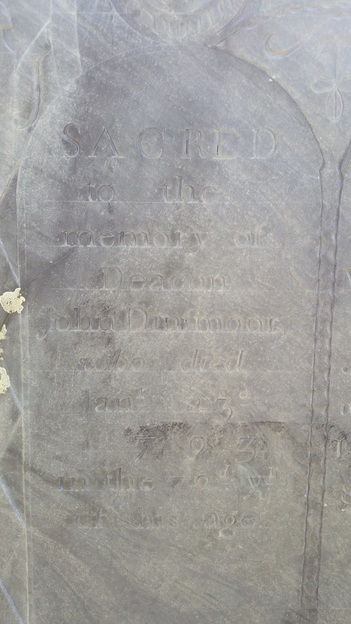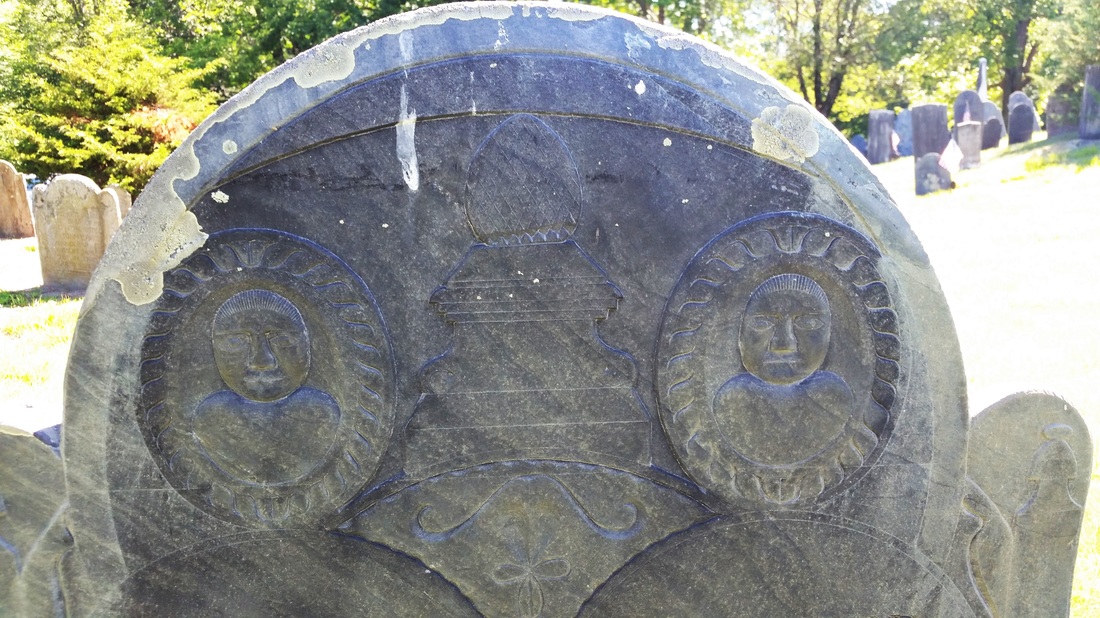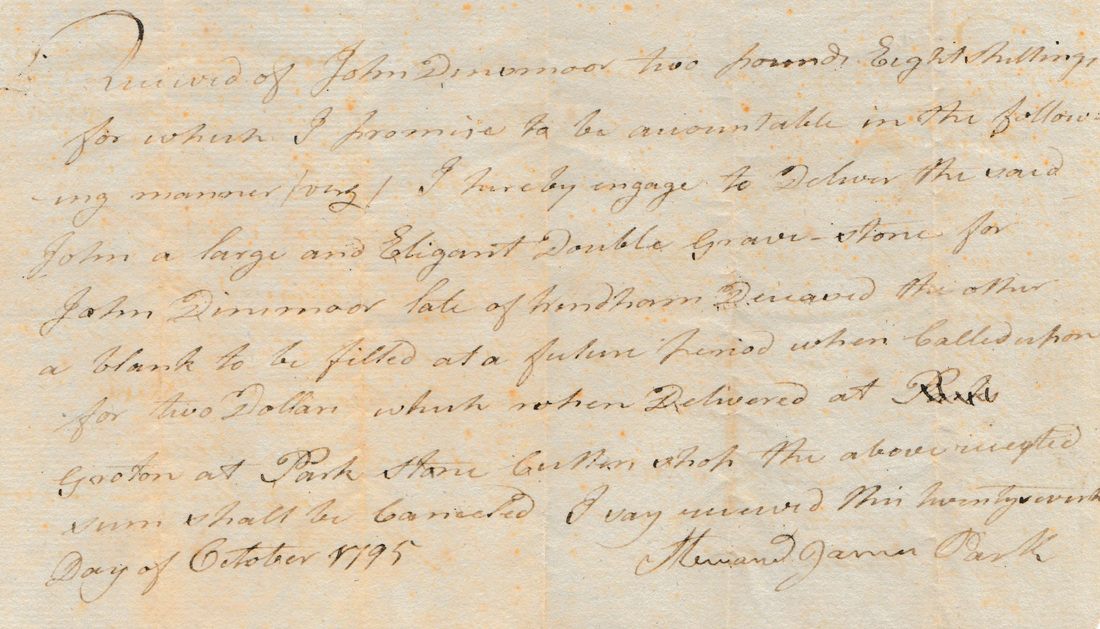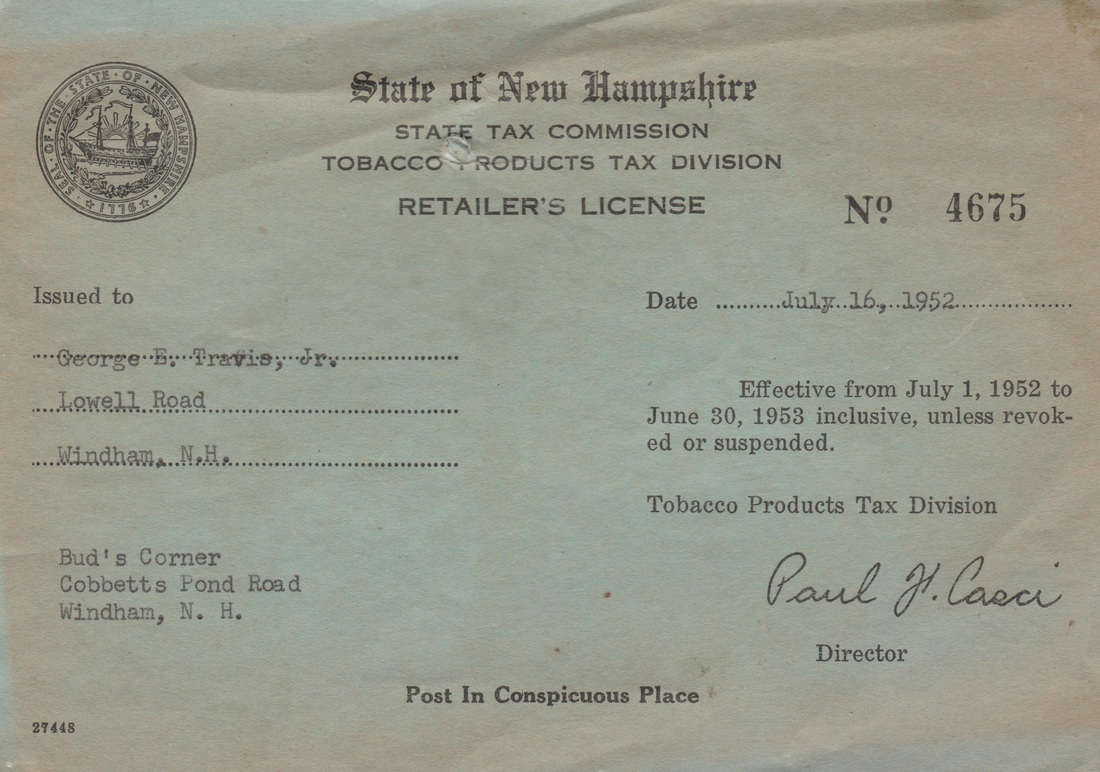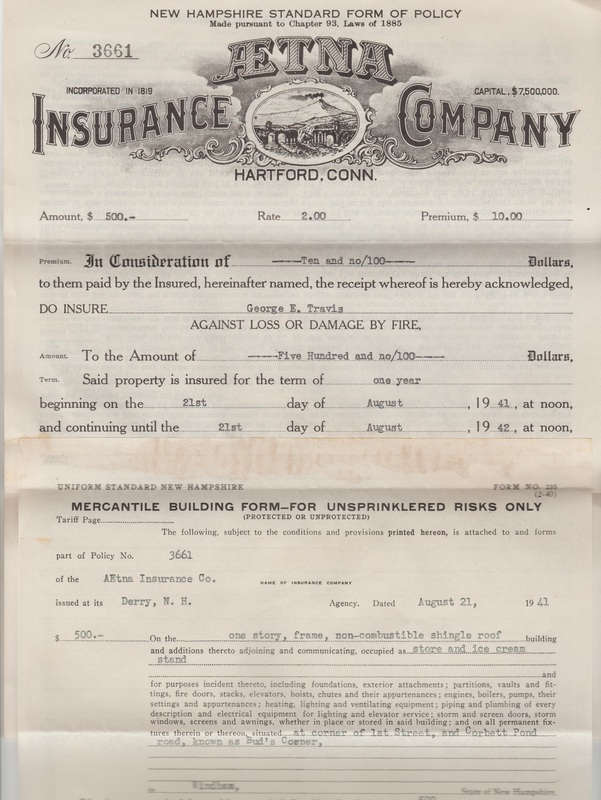|
In June of 2015, I had posted the 1795 receipt for the purchase of John Dinsmoor's "elegant double grave-stone." In summary: John Dinsmoor was born in Ireland in 1721 to Robert and Margaret Orr Dinsmoor, and came to Windham with his parents and three siblings in 1730. John later married Martha McKeen of Londonderry and the their family grew to include thirteen children. Dinsmoor is recorded as having been one of the leading men of the town, serving as town clerk, a moderator at town meetings, selectman, justice of the peace, elder at the Presbyterian church, and a delegate to the Provincial Congress at Exeter in 1775. He died in Windham in 1793. However, as evidenced by the late 1795 bill above, it was approximately two years before a, "large and Elegant Double Grave - stone" was purchased for his grave by his son, John. The bill for two pounds eight shillings also included a provision for the second half of the stone to be carved for two dollars at a later date, following the death of Martha. Since I last wrote about the receipt I have had the opportunity to photograph the gravestone, which is one of the larger, more detailed gravestones located in the Cemetery-on-the-Hill. Also, I have been able to learn more about the stone carver, James Park. The Park family of Groton, MA carved many of the turn of the nineteenth century gravestones in Groton. A building built by, and for, the Park family is currently the oldest extant brick building within the town lines of the original Groton; it is now located on Park Street in Ayer.
0 Comments
George "Bud" E. Travis Jr. opened his summer food, beverage, and ice cream stand, named Bud's Corner, in 1940. Situated across the street from the Cemetery on the Plain, the stand served summer vacationers and townsfolk alike. Those spending a summer day at one of the beaches of Cobbett's Pond, could take a short walk to the south end of the pond, where Travis sold summer staples such as fried clams and ice cream. Everything on the menu was made fresh, ingredients being procured locally. The clams were often purchased from Joseph G. Coppola who operated out of Seabrook; the cost of the clams in 1948 was just $5.25 per gallon. Five different flavors of ice cream: vanilla, chocolate, strawberry, maple, and butter pecan, were offered for sale at the stand in 1940. The ice cream, which was purchased from Harry B. Call, cost $2.75 per two and a half gallons. Call also supplied the pies that were served at the stand in the early 1940s. The Salem Coca Cola bottling company supplied the majority of the bottled soda, one of the stand's top selling refreshments. In 1940 a case of bottled Coca Cola cost $0.80; this price rose only about fifty cents by the early 1960s. Other brands of soda were served, including Frostie Old Fashion root beer, which was bottled in Maryland by the Catonsville Bottling Company. A case of the bottled root beer cost just pennies less than a case of Coca Cola. Potato chips, another summer staple, were bought fresh from the Granite State Potato Chip Company located just a few miles away in Salem. Travis routinely purchased several dozen 5 cent bags to resell at his stand. Other items, including dairy products and eggs, were frequently purchased fresh from farms in Salem; Marsh's Dairy and Turner's Dairy supplied the majority of such products. Although food certainly was the focus at Bud's Corner, other products, including cigarettes and the Sunday newspaper were sold at the stand. Operating expenses for a season ran about several thousand dollars in the 1940s. Travis, a meticulous record keeper who saved every receipt, recorded the expenses for a single season as follows: $350 - Tonic $150 - Chips $1,130 -Beer $1,035 - Cream $1,826.09 - Tobacco $1,000 - Groceries $200 - Milk $250 - Bread $100 - Crackers $150 - Ice $100 - Gas $100 - Clams $80 - Frankfurters $30 - Sunday Paper $100 - Electricity $150 - Rent $350 - Help Expense ------------------------------- $7,101.09 The stand was a true Cobbett's Pond institution, and remained open for over two decades. Below is the 1941 insurance policy for Bud's Corner. The $500 policy from the Aetna Insurance Company, which was good for one year with a $10 premium, covered Travis' "one story, frame, non-combustible shingle roof building...occupied as [a] store and ice cream stand."
George E. Travis Jr. was born in Lawrence, MA, but his family removed to Medford, MA shortly after his birth. He was raised and educated in the city of Medford. George Travis took an interest in carpentry and joined the local union, Carpenter’s Local 111; he was a member of the union for seventy years. In 1929, Travis purchased two small tracts of land in Windham, situated near the center of town; he purchased both from Ethel Whitehead of South Boston, MA. Both plots were near the antique home he later purchased, and in which he raised his family with his wife, Mildred. It was only one year later that Travis purchased two lots of land in the Lake Shores Development Trust along the west shore of Cobbett's Pond, near the north end. He purchased lots 26 and 27 in block B, which was not too far from the shoreline, although there was another block of lots directly in front of block B. The entire development consisted of 975 lots, each of which was approximately twenty feet by one hundred feet. Amenities for those who purchased lots included a playground for young children and a community beach. Although the price Travis paid for his lots was not recorded in the deed, many similarly sized parcels sold for between $20 and $50; his lots likely being towards the higher end of the range considering their close proximity to the waterfront. Just over a decade later Travis, then known by the nickname "Bud", opened Bud's Corner at the south end of the pond where Rogers Field is today. The local institution sold refreshments to those spending their summer on the pond. Below is a slideshow of 1930s photographs taken at Cobbett's Pond. All photographs were discovered in an album kept by the Travis family. If anyone is able to identify the people or the summer cottages, please contact me as I'd be greatly interested This short, approximately 20 minute, documentary was put together by the Friends of Moeckel Pond. The documentary not only presents the historic importance of the pond and Simpson's Mill, but stresses how valuable of an asset the pond is to the community. According to Morrison's "History of Windham", Simpson's mill was constructed by Joseph Simpson between 1788 and 1789. Although Simpson was the proprietor of the mill, who was also the mill's namesake, the business was originally owned by a consortium of shareholders. Joseph was known for being a "fine carpenter and millwright." Situated on Simpson's Pond (now Moeckel Pond), the mill would have been patronized by customers from both Windham and Pelham. No more than a few years prior to 1883, when Morrison published his monumental tome on the town's history, Thomas W. Simpson was operating the mill as both a gristmill and sawmill. There was also a planing and shingle mill attached for the purpose of finishing roughly cut lumber for building material. According to "A Brief History of Moeckel Pond" (published on www.moeckelpond.com), Thomas Simpson was of no direct relation to the original builder of the mill, Joseph Simpson. While there were numerous owners of the property during the nineteenth century, Thomas Simpson remained the owner for most of the latter half of the century. Thomas was active in local affairs and served as a selectman and moderator of town meetings for several years. By the late 1890s the mill had fallen into disrepair. However, according to "Rural Oasis", the mill continued to operate into the early years of the twentieth century and the, "business continued to prosper through the years and had earned the distinction of being one of Windham's oldest establishments when the property was finally sold." In May of 1921, William and Gertrude Moeckel purchased the property. It was their surname from which the pond eventually came to be known by "Moeckel Pond". Within the following decades the mill was essentially destroyed by nature, damage that was only added to by the Hurricane of 1938, which caused widespread damage throughout the region. The dam also sustained damage, and there has been an effort made recently to restore the dam and preserve the historic property.
|
AuthorDerek Saffie is an avid Windham historian who enjoys researching and sharing his collection with all those interested in the history of the New England town. Archives
November 2019
Categories
All
|

